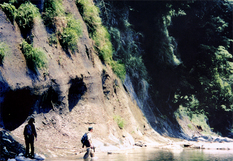Bulletin of the Geological Survey of Japan Vol.51 No.10 (2000)
Cover photograh | Table of Contents |
Cover photograh

Outcrop photograph of the lower part of the Kobana Formation, Arakawa Group, in the Karasuyama area, central Japan.
Some Neogene marine sequences in Japan are interbedded with volcaniclastic material suitable for radiometric dating. Among them, Arakawa Group is particularly suited for the study of two independent stratigraphic tools: biostratigraphy and geochronology, because it contains both calcareous and siliceous microfossils and interbeds many datable volcaniclasic layers (see Takahashi and Iwano, this volume). The integrated stratigraphic investigation for the Arakawa Group is one of the recommended activities of the Subcommission on Geochronology (SOG) of the IUGS:“Integrated Stratigraphy of the Miocene Sequence: Miocene from Japan”.
(Photoed by Masaki TAKAHASHI, May l999)
Table of Contents
| Title | Author | |
|---|---|---|
| Fission track age of the Og1 Tuff in the Miocene marine sequence of the Arakawa Group in the Karasuyama area, central Japan | Masaki TAKAHASHI and Hideki IWANO (477-484) | 51-10_01.pdf(1,986KB) |
| Improved PIXE technique at Hiroshima University to detecte light elements in water | Fumitaka NISHIYAMA, Tetsuya KIKUCHI and Satoshi MURAO (485-494) | 51-10_02.pdf(2,657KB) |
| Paleomagnetism and fission-track ages of the Miocene sequence in the Kanazawa and Iozen areas, central Japan | Yasuto ITOH, Akiko YAMAMOTO, Hideki TWANO, Tohru DANHARA and Mahito WATANABE (495-504) | 51-10_03.pdf(1,726KB) |
| Review on Exceptional Large Ore Deposits | Rongiu PEI. Yasuo KANAZAWA and Ping'an WANG (505-516) | 51-10_04.pdf(1,439KB) |
| [ Notes and Comments ] A fundamental design for exhibiting geological pictures and illustrations on personal-computer displays |
Kazuhiko KANO, Hideo HOSHIZUMI, Toshimitsu IWAYA, Shun NAKANO and Yoshihisa KAWANABE (517-535) | 51-10_05.pdf(9,724KB) |
Geological Survey of Japan, AIST
- About GSJ
- Our Activities
- Purchase guide
-
Publications and Database
- information
- Bulletin of the Geological Survey of Japan
- bull2025(Vol.76)
- bull2024(Vol.75)
- bull2023(Vol.74)
- bull2022(Vol.73)
- bull2021(Vol.72)
- bull2020(Vol.71)
- bull2019(Vol.70)
- bull2018(Vol.69)
- bull2017(Vol.68)
- bull2016(Vol.67)
- bull2015(Vol.66)
- bull2014(Vol.65)
- bull2013(Vol.64)
- bull2012(Vol.63)
- bull2011(Vol.62)
- bull2010(Vol.61)
- bull2009(Vol.60)
- bull2008(Vol.59)
- bull2007(Vol.58)
- bull2006(Vol.57)
- bull2005(Vol.56)
- bull2004(Vol.55)
- bull2003(Vol.54)
- bull2002(Vol.53)
- bull2001(Vol.52)
- Bulletin of the Geological Survey of Japan(old)
- Annual Report on Active Fault and Paleoearthquake Researches
- Reports, Geological Survey of Japan
- CCOP-GSJ Groundwater Project Report
- CCOP Technical Bulletin
- Cruise Report
- Geological Hazards
- Learning and Education
- GSJ Database Collection
- Collection of links

